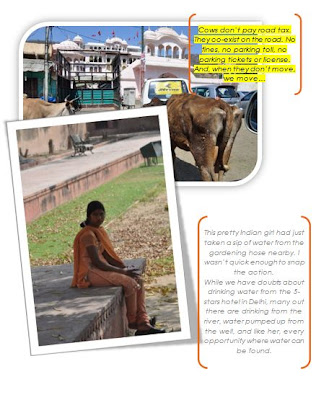
India had always been one of the countries that I, or rather, my left brain wanted to visit. On the contrary, it is also a country that the logical side on me, least wants to visit. Let me explain the conundrum.
I think, I like India because it is a country filled with rich history and culture, compiled from the roots of Indians, Persian, British and the Middle East (as far as I know). It is also where the magnificent symbol of love, The Taj Mahal sits.
To feel the cold white marble of the Taj, one of the Seven Wonders of the World, sits right at the top of my to-do list. Authentic Indian food is another pull factor to India. To try the true-blue Chicken Masala, Chicken Tikka and Chicken Tandoori will be a great pleasure to my taste buds, I imagine.
On the other hand, my right brain is afraid of the environmental conditions. The heat that literally sears your skin in the open (more than 40 degree Celsius of dry heat from March to June); the air pollution that sets your whole respiration system into a “4-wheel drive mode”; the contaminated water that churns your stomach faster than any of those roller coasters ride in Magic Mountain; the number of power cuts/losses that exceeded the counts of your fingers, and the noise pollution – the incessant blaring of horns on anything that comes with wheels, could possibly wakes the dead. Adding up all of these factors, would you give up your hard-earned money in exchange for a trip to India? No chance, India is probably one of the last places on earth you would want to visit.
Coincidently, I was given the opportunity to experience India for myself. I was to attend a business meeting in New Delhi. And so I went, taking my wife, my “Supreme Court judge”, along for an extended trip after the meeting.

True enough, my left brain was correct, but so was my right. What surprised me was not the weather conditions or the physical place itself, but the People.
I noticed that Indians (most) are really friendly and show great hospitality, with sincerity. I was lavished with tip-top service throughout my stay. I was most impressed that a cell-phone that I had absent-mindedly left in the hotel restaurant was found a few hours later. Even in Singapore, the odds of having your lost phone returned are near zero.
As always, there were a few bad eggs in the basket such as the tour-guide who was able to manipulate his service like a switch, dropping his service level to ground zero when tips presented seemed too “ light-weighted” for him, and the grouchy Airport lounge staffs that ,sadly, left a lasting, bad impression, before we flew back to Singapore.
 Other than the friendliness, the daily life of the Indians, showed me the other side of life that many of us, as Singaporeans, have forgotten -the survival instincts and never-say-die attitude. Looking back, I have taken many things in life for granted. I am no photographer and had no interest with carrying a bulky camera around. However, on this trip, the urge of capturing these moments was so great that I cannot stop clicking away. I have selected a few pictures to share with you.
Other than the friendliness, the daily life of the Indians, showed me the other side of life that many of us, as Singaporeans, have forgotten -the survival instincts and never-say-die attitude. Looking back, I have taken many things in life for granted. I am no photographer and had no interest with carrying a bulky camera around. However, on this trip, the urge of capturing these moments was so great that I cannot stop clicking away. I have selected a few pictures to share with you.



Food for thought…
When life does not bend in your favour, do not wait for someone to come by and do it for you. Do-It-Yourself(DIY), within a ‘right frame’. I guess such a ‘can-do’ attitude is where entrepreneurship begins; where creativity starts.
Many Singaporeans are blessed without having to experience the harshness of life, as they do in India. Yet, this harshness has probably shaped the toughness of character within – the instinct of survival, the ‘ever-ready’ will power, the creativity, and the guts of risks-taking. While many of us are found wanting in these virtues, I believe, with a little effort to re-focus our energy and fine-tune our mindset, we can evolve, stronger.
For a start, I believe that the first change that we can all make, is to stop wasting negative energy on why and how it cannot be done (cannot-attitude). Mr Lee Kuan Yew once said, “Focus on what works”. Concentrate on developing the ‘can-do’ attitude, and start asking “How do I do it?” instead of “Can it be done?”. With a leap of faith, even in an environment such as in Singapore, I believe, we can also groom a ‘can-do’ attitude.
Someone asked, “Will you come back to India again?” I hesitated. I guess, it is my left and right brain trying to outdo each other again. I took a few blinks of my eyes as if to shut off all the thoughts process and said, “maybe…yes..”
10 items to bring along for your India trip:
1. Power plug converter (EU type)
2. Cap to block the sunlight
3. Sunshade to block the sunlight
4. Sun-block lotion
5. Torchlight in case of power trip
6. Charcoal pills for stomach upset
7. Lots of small notes for tips
8. Bottles of mineral water
9. Wet Tissues
10. Respiratory mask

 With the clearly written instructions from the manual that came with the standard package, I managed to join the two cables in less than five minutes. Sharing similar concerns as any of our customers would have, more skeptical of my own technical skills than of the insulation displacement technology, I turned on the fan and voila. The power flowed flawlessly and I was enjoying the breeze from the fan, bringing a smile to my face.
With the clearly written instructions from the manual that came with the standard package, I managed to join the two cables in less than five minutes. Sharing similar concerns as any of our customers would have, more skeptical of my own technical skills than of the insulation displacement technology, I turned on the fan and voila. The power flowed flawlessly and I was enjoying the breeze from the fan, bringing a smile to my face.







